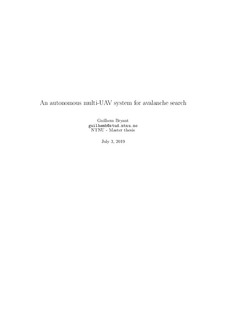| dc.description.abstract | This work aims at theorizing and designing a multi-UAV system for localizing avalanche victims in an optimal way.
Using UAVs instead of human rescuers for victim search offers several advantages such as their high velocity, their agility and the fact that they do not feel pressure, which often leads to human mistakes.
Furthermore, using multiple UAVS make missions possible whatever the amplitude of the disaster thanks to the scalability of multi-agent systems. It also provides robustness through redundancy: if a UAV fails, the rest of the fleet keeps operating. Finally, it divides the time for finding victims by the number of UAVs working, and this is a property of primary importance when big avalanches happen.
The actual rescue is not considered due to obvious limitations in terms of UAV payload, hence this task is left to human rescuers.
It is mandatory for victims to emit some kind of signal so that agents may sense it and try to localize the victim. Throughout this work, focus is given to avalanche transceiver, although alternative technologies are studied.
The final contribution yielded by this thesis is a detailed abstract model of the system, offering an overview of the wide range of challenges to overcome to make this system real. Additionally, a simulation ecosystem is deployed to test the system. | |
